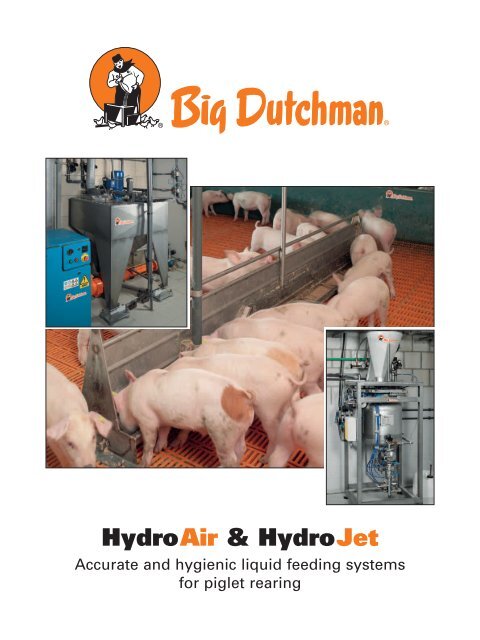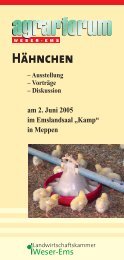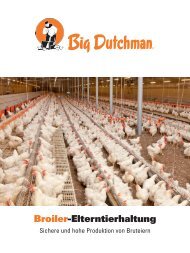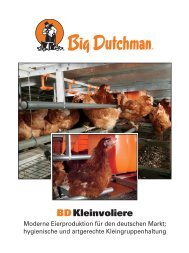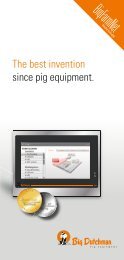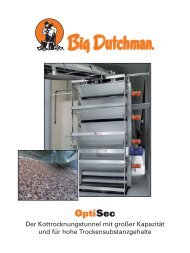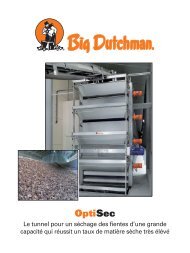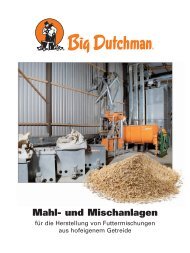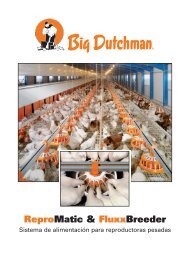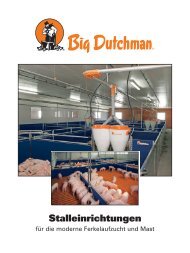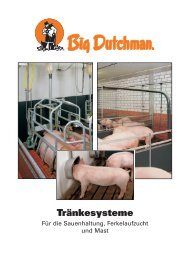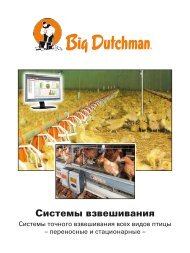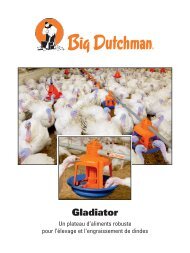HydroAir_HydroJet_e.pdf - Big Dutchman International GmbH
HydroAir_HydroJet_e.pdf - Big Dutchman International GmbH
HydroAir_HydroJet_e.pdf - Big Dutchman International GmbH
Create successful ePaper yourself
Turn your PDF publications into a flip-book with our unique Google optimized e-Paper software.
<strong>HydroAir</strong> & <strong>HydroJet</strong><br />
Accurate and hygienic liquid feeding systems<br />
for piglet rearing
<strong>HydroAir</strong> & <strong>HydroJet</strong> – liquid feeding systems for piglet rearing for high demands<br />
<strong>HydroAir</strong> and <strong>HydroJet</strong> were developed for piglets in<br />
the rearing phase with weights from 6 to 40 kg. Both<br />
systems can also be used for sow feeding. <strong>HydroJet</strong><br />
is especially well suited for small units with up to<br />
1000 piglets, whereas <strong>HydroAir</strong> is best used on farms<br />
with 1000 piglets and more.<br />
Both systems can be used for preparation of feed<br />
mixes from up to 40 different components thus providing<br />
flexibility in the use of low-cost ingredients.<br />
The feed can be prepared per valve (<strong>HydroJet</strong>) or, if<br />
the same feed mix is used simultaneously for several<br />
valves (<strong>HydroAir</strong>), which saves a lot of time.<br />
Thanks to their compact design, <strong>HydroAir</strong> and Hydro-<br />
Jet may be installed in very small feed kitchens<br />
which is another advantage compared to traditional<br />
liquid feeding systems.<br />
What makes these two systems so different?<br />
<strong>HydroAir</strong>-Synchron – this double-tank system allows a wide choice<br />
of different recipes to be immediately available for supply of large<br />
stocks<br />
Sensor feeding systems are becoming more and<br />
more important in piglet rearing. Such systems<br />
make it possible to supply small and fresh feed por -<br />
tions several times a day thus minimizing the risk of<br />
infection and diarrhoea. Furthermore they help to<br />
reduce a possible decline in daily weight gain after<br />
weaning (keyword: weaning problems).<br />
As <strong>HydroAir</strong> and <strong>HydroJet</strong> allow for preparation and<br />
distribution of very small feed quantities, they are<br />
ideally suited for repeated supply of fresh feed several<br />
times per day. Of great importance is the ability<br />
accurately to adjust the feed mix to the piglet’s nutrient<br />
requirements and to supply a warm feed soup as<br />
well as providing a gradual change of the feed mix<br />
(phase feeding).<br />
As every rearing expert knows, feed consumption,<br />
especially in the first couple of days, is much higher<br />
if the liquid feed is supplied warm. <strong>HydroAir</strong> and<br />
<strong>HydroJet</strong> allow the temperature of the feed to be<br />
adapted to the age of the piglets by means of feed<br />
curves.<br />
Since the feed is transported to the trough by means<br />
of compressed air, all of it is eaten by the piglets. The<br />
feed pipes are left completely empty after feeding<br />
thus there are no residues.<br />
<strong>HydroAir</strong> and <strong>HydroJet</strong> with sensor trough<br />
and the correct animal : feeding place ratio<br />
On-farm experience has shown that piglets should<br />
be fed at a sensor-controlled trough. This way, fresh<br />
feed is always available as required (appetite-controlled).<br />
Every piglet should have approximately 8 cm<br />
of feeding space. This corresponds to an animal :<br />
feeding place ratio of 1 : 1 at the beginning of the<br />
rearing period and a ratio of 2 : 1 at the end of the<br />
rearing period. Such conditions make for uniform<br />
feed consumption in the group with individual<br />
weight gains of 450 g and more.<br />
<strong>HydroAir</strong> in combination with sensor feeding
<strong>HydroAir</strong> – flexible and powerful<br />
<strong>HydroJet</strong> – for small stocks<br />
The main components of <strong>HydroAir</strong> include:<br />
) mixing tank with agitator and tank cleaning;<br />
) electronic weighing with 100 g scale resolution;<br />
) positive displacement pump with a pump<br />
capacity of 3600 l/h and a supply pressure of<br />
up to 8 bar;<br />
) feed valves;<br />
) pipelines with a diameter of 25 or 32 mm;<br />
) compressor with 4 or 7.5 kW motor, max.<br />
pressure 10 bar.<br />
Feed is prepared in a weighed mixing tank made of<br />
stainless steel, available in different sizes (250, 500,<br />
750 l). One <strong>HydroAir</strong> can supply up to 4500 piglets.<br />
The main components of <strong>HydroJet</strong> include:<br />
) compact high-pressure mixing tank made of<br />
stainless steel (95 litres);<br />
) electronic weighing with 10 g scale resolution;<br />
) feed valves;<br />
) pipelines with a diameter of 25 mm;<br />
) compressor.<br />
<strong>HydroJet</strong> allows the preparation and delivery of very<br />
small quantities – approx. 2 kg – per valve. The<br />
system operates with compressed air that means<br />
no feed pump is required.<br />
<strong>HydroJet</strong> is delivered pre-assembled and fits into<br />
even the smallest feed kitchen.<br />
One <strong>HydroJet</strong> can supply up to 1000 piglets.<br />
The feed valves that are used consist of a T-ball valve<br />
and a control unit. They operate electro-pneumatically<br />
and need an air pressure of at least 6 bar.<br />
Both systems are controlled<br />
by an MC 99 NT<br />
feeding computer. The<br />
feeding computer is<br />
capable of highly demanding<br />
taks such as monitoring,<br />
feeding protocols<br />
and thorough evaluation<br />
throughout the entire<br />
growing period.<br />
Feed valves installed in the central corridor
Advantages of compressed air technology<br />
In contrast to many other liquid feeding systems,<br />
<strong>HydroAir</strong> and <strong>HydroJet</strong> operate by means of compressed<br />
air. That means:<br />
) residue-free delivery of feed;<br />
) no feed remains in the feed lines;<br />
) vitamins and minerals can be fed without problems<br />
(as they will not be left adhering to the inside of<br />
the pipes after feeding is finished);<br />
) phase feeding is possible;<br />
) ensures ideal hygienic conditions and thus healthy<br />
piglets;<br />
) installation of the valves outside of the compartments,<br />
therefore no electrical equipment in the<br />
compartments.<br />
Hygiene – <strong>HydroAir</strong> and <strong>HydroJet</strong> set high standards<br />
Optimum hygienic conditions are a basic requirement<br />
for high feed intake and feed conversion. The feed is<br />
transported to the trough by means of compressed air.<br />
Our well-proven acid fogger distributes<br />
very small quantities of disinfectant<br />
solution to the tank several times a day.<br />
This way, the creation of a contaminant<br />
film which would otherwise occur after<br />
longer times of use is avoided. The fog<br />
penetrates every corner of the mixing<br />
tank, thus ensuring optimum disinfection<br />
and hygiene.<br />
In addition, the feed pipes can be rinsed<br />
thoroughly with acidfied cleaning water.<br />
The entire system is controlled by an<br />
MC 99 NT feeding computer.<br />
It is then dispensed without any residues. This means<br />
that the feed lines will be completely emptied, there -<br />
fore providing excellent hygienic conditions.<br />
Acid fogger for tank cleaning<br />
Healthy piglets thanks to excellent hygienic<br />
conditions<br />
Diagram of the liquid feeding systems <strong>HydroAir</strong> and <strong>HydroJet</strong><br />
<strong>HydroJet</strong><br />
<strong>HydroAir</strong><br />
<strong>Big</strong> <strong>Dutchman</strong> Pig Equipment <strong>GmbH</strong><br />
P.O.Box 1163 • 49360 Vechta • Germany<br />
Tel. +49(0)4447-801-0 • Fax +49(0)4447-801-237<br />
www.bigdutchman.de • E-Mail: big@bigdutchman.de<br />
Technical details subject to change. e 2/2008


